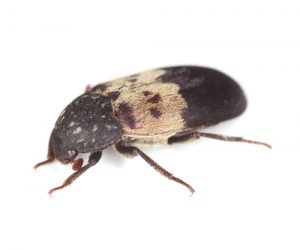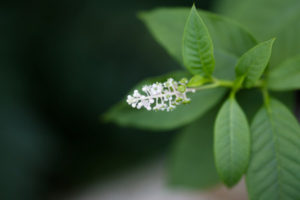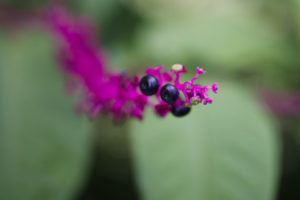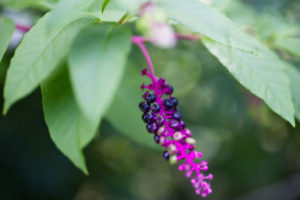Mice can eat pokeweed instead of bait
By Zachary Ciras on August 26, 2022.
Zack Ciras speaks from Prospect Hill Park in Waltham, MA about a problem account in Dedham, MA where the mice have been digging in a tenant’s house plants, but are not consuming the rodenticide baits. What competing food sources could they be eating? Pokeweed may be one option they have.
Setting the Scene
Welcome. I’m Zack Ciras, and this is Colonial Pest Control. I’m in beautiful Waltham, Massachusetts, at the bottom of Prospect Hill Park. Spoke with a technician before I went up. He’s in Dedham, Mass today, dealing with a two-family home for some sort of rodent activity. It’s a fieldstone foundation. It’s an old house. One of the units is actually undergoing some construction, so there’s a lot of upheaval within the structure. It’s the end of a road, intersecting with a couple other small roads, so it was a pretty densely packed area, a lot of structures, multiple family structures in the same area. So there’s some population density right in that immediate neighborhood, let alone being in a city itself.
So, the unit that’s not undergoing construction is occupied by a tenant. That tenant’s been reporting some sort of rodent activity, and she’s tried her own glue boards and different measures of trying to keep them at bay. We’ve put out bait stations there. A couple of the bait stations had some activity on them, but really, not the type of activity you’d expect to see in a normal situation. This happens sometimes. It’s not all normal, by the books situations.
Are we Sure they are mice?
What the main issue is for this week for her is she has houseplants, and she’s been finding digging in the soil of the houseplants. I’ve seen this before. It could be mice, could be shrews, could be voles. Voles dig in the soil for sure. They usually eat roots of plants, and you’ll see the tunneling in the grass sometimes. You’ll see the tunneling underneath the snow, especially in the winter. You’ll see tunneling in your mulch beds, and they’re going for the roots of the grass, of your vegetable garden, for flower gardens. Your flower beds, they’ll eat the roots of the flowers that are in there. But I don’t think that’s what she’s seeing in there. The droppings that he’s finding are larger.
It could be shrews. They can occasion inside of a house, but they’re insectivores. They’re really looking for a meat meal. They’ll eat insects, they’ll eat aquatic life, frogs and things like that. They’ll actually eat mice and small birds, so they are meat eaters. But I don’t usually see shrews digging in potted plants like that.
What I have seen in the past is deer mice. Deer mice are a particularly crafty nemesis if you have them in your home. The commensal rodents that we typically deal with are house mice, Mus domesticus, just domestic house mice, the normal, gray mice, white belly, usually gray to blackish fur. Sometimes, there’s some reddish-brown hues in it. Those are the ones that are more associated with a mouse infestation in your house or in your apartment. Another commensal rodent that’s in the area is Norway rats, Rattus norvegicus. They’re another commensal rodent.
What is a commensal rodent?
What commensal means is basically just outside animals that want to share your table. Com Mensalis is the root words for commensal, and it’s together, your table, so to share your table basically means they want to eat where you’re eating. They want to get into your pantry, into your cupboards, eat your cereal, eat your scraps of food, get into your trash and eat that kind of food. And she has had some of that.
Before we went out and got some control, she did have some feeding in her pantry, in her cabinets, some of her food that wasn’t in tight stored container that was difficult for them to chew through, they were able to access that and get into some food. But now she’s getting digging in her houseplant soil. She’s done a good job cleaning up any kind of sanitation concerns we had. She’s packaged her items into tightly stored containers, that are difficult to get into unless you’re a human who can pry the top open, so she’s really gone out of her way to try to mouse-proof her apartment, considering it’s an old house and the foundation probably could use a good repointing.
What are they eating?
So that begs the question, what are they eating? They have to eat something. Well, there’s a few things that they could eat. One could be just remnants of her food that have been stored already inside wall voids, inside of cavities, and hidden places inside the apartment. That certainly happens, especially if there’s a pet in the house, dog food, cat food, things like that can be easily stored inside a cheek of a rodent, brought someplace near the nest, and have a food store that could last weeks, or months, or more. One thing that happens in those situations, besides the rodents being able to thrive without having any new food, and potentially ignoring our baits and our lures on our traps, in favor of the food that they’re already accustomed to eating, is secondary pests.
Secondary Pests
What I mean by a secondary pest is a pest that comes to be a pest inside of your house because of another pest. When a mouse stores dog food, or cat food, or dried goods inside a void or some kind of hiding hole, and that sits for a long time, you could have pantry pests that actually emerge from there. You could have Indianmeal moths that come out of nuts and seeds that are stored inside of a wall void or ceiling void. There was a house in Arlington, Mass that a technician just went to with a lot of Indianmeal moths in the basement boiler room, and our customers are new to the house. They just took the house over within the last year, and we just were brought in recently. She had another company come in to try to find a source. They couldn’t. They did a spray in the basement, wherever the moths were. It dropped down the numbers for a while, but they just came back again.

Larder Beetle
One of our Colonial technicians went in there and saw, in the basement boiler room where they were most active, a lot of evidence of mice. And he said, “Well, what are the mice eating?” Well, the previous people fed the birds a lot. So those mice were getting into that boiler room through a hole next to the chimney that my technician found, and they were actually storing hoards of birdseed in the ceiling. So we were able to get into the ceiling, inject in, and do some application into the ceiling to eliminate the source where they were. So that Indianmeal moth infestation could be a secondary pest as a reaction, more or less, to the actual mouse infestation.
With the dog kibble and cat kibble, things like that, you can have carpet beetles emerge, black carpet beetles, varied carpet beetles. You could have larder beetles, or really, any other sort of dermestid beetle that feeds on things like animal hides from dead mice or feeds of pantry products, like kibble and other dried goods that are brought inside the wall void. So that could be a food source and a reason why they’re not feeding on the rodenticide baits.
Check the surroundings of the home
Another thing to consider is the outside surroundings. As I said, we have pretty good population density in this neighborhood, and any place in the city and East suburbs outside of the city, we’re seeing a lot of this, where there’s competing food sources outside of the house, that the mice and rats are feeding on. So there’s a lot of competition just from human activity in those areas. That doesn’t even consider things like seeds, and nuts, and acorns, and insects. Mice are actually pretty good omnivores. They’re going to adapt to anything. Deer mice, field mice, white-footed mice, they eat a lot of insects, as well as the native food that they find in the area, such as seeds, and nuts, and berries.
Peromyscus is the classification that we use for field mice, but the two main field mice that we have in Massachusetts and New Hampshire are deer mice and white-footed mice. White-footed mice, based on some limited studies, really seem to prefer insects for food, as their natural food source, if they’re not eating the human food. Deer mice eat insects as well, but they also eat a lot of seeds, and nuts, and berries, and natural food sources. We call Peromyscus mice semi-commensal, so they’re not entirely reliant upon human activity for food. I guess neither are house mice or Norway rats, but they’re more likely to be found in your trash can, and in your food, and in your pantry. They’re semi-commensal Peromyscus mice. They’ll thrive on just about anything that they can get, so they’re not necessarily in your pantry if they can bring in acorns and seeds from the outside.
Pokeberries
I was talking to my technician as I pulled into Prospect Hill Park in Waltham, and right in front of where I parked, something caught my eye, something I’ve seen before. I’ve definitely seen deer mice digging in planting soil inside houses and houseplants, and I’ve also seen piles of black seeds, and those black seeds are related to this plant right behind me. This is pokeweed or pokeberry, has a lot of different nicknames. Phytolacca is the genus name for this kind of plant. It’s native to North America.

White flowers of the Pokeweed plant

Pokeberries on the plant ripe to eat, some already eaten by mice
Phytolacca actually translates to plant with red dye. When the colonists came over to America and settled in cities like Waltham, they found a lot of this weed. It’s actually an herb that produces berries. They found a lot of this weed, this pokeweed, lying around. And you can see that the berries a are rich purple, and produce a really red juice. You can make a good dye out of it for textiles. You can actually use it to ferment and make a fairly cheap wine. Pollinators like it, and they have sizable black seeds inside of them.
The pokeweed plant itself has some parts of it that are toxic to mammals and to humans, so it’s not recommended that you just start eating them. Some people make an herbal tea in the springtime, when the leaves are young. A lot of animals do eat the berries. It’s toxic for deer, so they typically don’t eat the leaves. But we find a lot of birds feeding on the pokeberries. If you ever had birds over your car, that leave remnants on your car, and there’s a lot of purple in it, it might actually be after they’ve eaten pokeberries. It’s a pretty rich dye, pretty rich color that’s inside the berries.
And in homes, we’ll often find piles of black seeds. Some people think that they’re bugs, big stash of black bugs, but what we find is mice are bringing them inside the house to store and eat. We’ve found pokeberry seeds stored throughout winters, giant piles of them. The amount of food that a mouse needs to eat isn’t very much. It’s about 1/10 of an ounce per night, at multiple feeding sites. A gravid female, or a female mouse that’s with a littler, who’s pregnant, she will eat an ounce or more. She might eat her entire body weight every night, but for most mice, especially nondominant males and nonpregnant females, 1/10 of an ounce, little nervous nibbles here and there every day, so they can bring in a cheek full of pokeberries, a couple of acorns, and some birdseed from the feeder. They’re more than happy to eat on that, rather than chance the strange food that we’re trying to get them to go to.
Easy steps to mouse control: Exclusion, Elimination, and Education
It’s not a typical occurrence. We can usually get pretty good control with our traditional methods, but when those don’t work as well as we’d like, and the activity continues, we’re going to come back and think outside the box. Things like knowing what pokeweed is and what pokeberries are is a good tool to have. A huge part of pest control is experience and knowledge of what we’ve seen in the past and how we can address things going forward in the future. Education is a huge part of our program. We want to exclude, whenever we can, new pests from coming in the house, and in the case of mice, that’s really the secret weapon, is to find the holes and close the holes, and exclude new mice from getting into the structure.
A house with a fieldstone foundation that needs repointing, and hidden areas under decks and additions, it gets pretty complicated, so the exclusion might move to the inside, and trying to limit their free movement within the structure, especially in a multifamily home. You might have to go into each unit and exclude from the inside going out. Single-family homes, we really prefer to get them from the outside, close the holes going in.
And then the second aspect is elimination. With the elimination, we might use snap traps, sometimes glue boards, although they’re not really a preferred method unless they’re needed, and bait stations with rodenticide baits and tamper-resistant stations placed in the right areas, that are safe, out of reach, but still exactly where the mice are going to run to and be effective. That usually eliminates the situation with the mice actually still living inside the house. And then educating the customer, educating ourselves on an ongoing basis, with what to expect, what we’ve done, what we couldn’t have done, what we need to do possibly going forward, if there’s more exclusion that needs to occur, if there’s environmental conditions around the house, such as overgrowth with weeds, and pokeberries, and vegetation that they might be hiding in.
Exclusion, elimination, and education. Those are really the three pillars of safe and effective pest control, and when things might not be going exactly as planned, we can rely on our education to really find the reasons why it might not be succeeding as well as we would like. We can find the reasons why the mice aren’t eating the food, whether it’s competing food sources from humans, from pets, from the outside, and we can find the structural faults that might be contributing to an ongoing infestation. There’s always a reason, and same idea with mice. They have to eat something, so why aren’t they eating what we’re trying to give them? One of those reasons could be pokeberries.

Pokeberries on the plant, some ripe, some still green
Those are some of the thoughts I had about that mouse infestation in Dedham, from my perch here, Prospect Hill Park in Waltham. Pokeberries just caught my eye, and they might have caught the eye of the mice in Dedham as well. For Colonial Pest Control, I’m Zack Ciras. We’ll catch you next time.
Also See: Mice/Rodent Removal